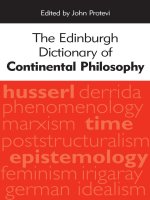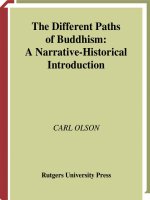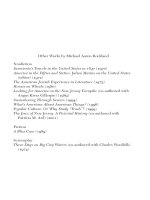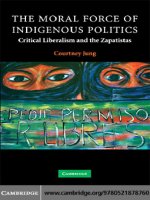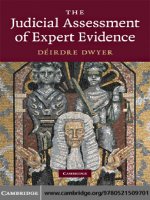rutgers university press the different paths of buddhism a narrative-historical introduction feb 2005
Bạn đang xem bản rút gọn của tài liệu. Xem và tải ngay bản đầy đủ của tài liệu tại đây (1.96 MB, 306 trang )
The Different Paths
of Buddhism:
A Narrative-Historical
Introduction
CARL OLSON
Rutgers University Press
The Different Paths of Buddhism
robin-bobin
robin-bobin
RUTGERS UNIVERSITY PRESS
NEW BRUNSWICK, NEW JERSEY, AND LONDON
The Different Paths
of Buddhism
A Narrative-Historical Introduction
CARL OLSON
robin-bobin
LIBRARY OF CONGRESS CATALOGING-IN-PUBLICATION DATA
Olson, Carl.
The different paths of Buddhism : a narrative-historical introduction / Carl Olson.
p. cm.
Includes bibliographical references and index.
ISBN 0-8135-3562-X (pbk. : alk. paper) — ISBN 0-8135-3561-1 (hardcover : alk. paper)
1. Buddhism. I. Title.
BQ4022.057 2005
294.3—dc22
2004011754
A British Cataloging-in-Publication record for this book is available
from the British Library
Copyright © 2005 by Carl Olson
All rights reserved
No part of this book may be reproduced or utilized in any form or by any means,
electronic or mechanical, or by any information storage and retrieval system, without
written permission from the publisher. Please contact Rutgers University Press,
100 Joyce Kilmer Avenue, Piscataway, NJ 08854–8099. The only exception to this
prohibition is “fair use” as defined by U.S. copyright law.
Manufactured in the United States of America
robin-bobin
This book is dedicated to
the memory of John Y. Fenton,
an early mentor and friend.
robin-bobin
robin-bobin
CONTENTS
Acknowledgments ix
PART ONE
Origins and Historical Development
1
Crows and Monks: Introduction 1
2
The Elephant and the Buddha 21
PART TWO
Therava¯da Philosophy and Practice
3
The Narrative Path of the Buddha 45
4
Ethical and Political Implications of Buddhist Narratives 68
5
The Tale of Beggars and Donors 88
6
The Feminine Narrative in Buddhism 110
7
Stories from Buddhist Villages 123
PART THREE
Major Maha¯ya¯na Movements and Schools
8
The Bodhisattva’s Path to Perfection 143
9
Secret Narratives: Philosophies of Emptiness 163
10
Devotional Voices of the Pure Land 184
11
Tales of Lamas: Tibetan Buddhism 201
robin-bobin
12
The No-Narrative of Seated Meditation: Zen 225
13
New Narratives: Recent Paths of Reform and Revival 245
Chronology 257
Abbreviations 261
Notes 263
Index 285
CONTENTS
viii
robin-bobin
ix
ACKNOWLEDGMENTS
This book is the outcome of over twenty years of teaching Buddhism on the
undergraduate level at large universities and a small liberal arts college in what at
times in the winter seems like Tibet. Critics might assert that I should have spent
another twenty years working on the subject. I would have to agree, because the
Buddhist tradition is very rich, complex, and widespread. It is impossible to do
Buddhism full justice in a single volume, and I have not attempted to cover every-
thing. This book focuses on major highlights of the tradition from India, Tibet,
China, and Japan, and also takes a look at Buddhism on the village level in such
countries as Sri Lanka, Myanmar (Burma), and Thailand. This book is intended for
college-level courses and instructors who are not fearful of challenging students.
After composing a book, there are many people whom one should thank.
Most important, I want to thank the many Buddhist scholars who have shaped my
understanding of the tradition and this book. It is more their book than mine. I
thank former Dean Lloyd Michaels and President Richard Cook for giving me the
Teacher-Scholar Chair in the Humanities at Allegheny College, which gave me free
time to research and begin writing this book at Clare Hall of the University of
Cambridge. I want to express my appreciation to the staff and fellows at Clare Hall
for a wonderful adventure and for creating a terrific atmosphere in which to work.
My time spent with Anindita and Julius Lipner was a major bonus of my stay in
the beautiful town. I also must thank Peggy for her understanding, generosity,
hard work, and love to pursue my fellowship and work; and Casey for teaching me
about friendship and companionship. I would be remiss not to thank my col-
leagues Glenn and our rookie Eric for sharing their collegial spirit. I also need to
thank the people at Rutgers University Press, especially David Myers for the faith
and encouragement he gave me at the start. These good people also include Kristi
Long and Adi Hovav. Kristi’s constructive criticism and suggestions helped to
improve this book, along with the comments of an anonymous reviewer. Finally,
I want to thank the many students whom I have taught over the years for allow-
ing me to have fun and to share what little I know with them.
Illustrations 1, 2, 3, 14, 15, 16, 17, 18, 19, 20 are photos taken by the author at the
British Museum, London. Illustrations 4, 5, 6, 7, 8, 9, 10, 11, 12, 13, 14 are photos
used by permission from the Asian Religious Media Resources, Yale Divinity
robin-bobin
School, New Haven. Illustrations 21, 24, 25 are photos taken by the author on site.
Illustrations 22 and 26 are photographs in the author’s collection, source
unknown. Illustrations 27, 28, 29 are from Daisetz T. Suzuki, Zen and Japanese Cul-
ture (Princeton: Princeton University Press, [1959] 1970), used by permission. The
two maps are from Buddhism: Art and Faith, edited by W. Zwalf (New York: Macmil-
lan, 1985), and are used by permission.
ACKNOWLEDGMENTS
x
robin-bobin
PART ONE
Origins and Historical
Development
robin-bobin
robin-bobin
The early Buddhist tradition is sometimes characterized in the popular imagina-
tion of Westerners as somber, serious, austere, and pessimistic. Because of its
emphasis on suffering and rejection of the world for a more solitary life of contem-
plation and meditation, it is understandable how people could arrive at such a
characterization. But such a caricature would be incorrect and misleading. Within
the hardships of ordinary life, Buddhists have been able to find humor. In a com-
mentary to the text of the Dhammapada, a story is told about some old monks who
became friends with an old woman, the wife of a former member of their group.
When the old woman died, the monks were inconsolable. In order to help them
understand, the Buddha told them a story from the Kaka (Crow) Jataka (stories of
former lives) about their former existence as crows. One day, it seems, the mate of
one of the crows got very drunk, was swept out to sea, and drowned. The crows
attempted to save her by baling out the sea with their beaks, until they finally just
gave up their fruitless effort.
1
We can commiserate with the sorrow of the monks,
but we can also laugh at the absurdity of the desperate actions of the crows.
If the sea in this narrative is a metaphor for the suffering associated with life,
and if the crows are metaphorical figures for human beings, the impossible task
of the crows is analogous to the struggle of humans against the suffering of the
world. Like the sea-baling crows, humans need a life raft to help them navigate
the sea of suffering that is symbolic of human existence. During the fifth century
B.C.E. in India, a man named Siddhartha became the Buddha (Awakened One), and
he functioned as a life raft for all those suffering in the sea of pain. With his con-
cern for the absurdities and suffering associated with human life, the historical
Buddha functioned as a human savior figure, even though he was not considered
divine during his life. During the formative period of Buddhism, the Buddha was
considered an ordinary man of flesh and blood and a gifted charismatic teacher.
He was not an incarnation of a deity. He was simply a man who discovered the
truth by means of his own efforts and shared it with others.
1
1
Crows and Monks: Introduction
robin-bobin
The Buddha also did not function as a mediator, reformer, prophet, priest, or
theologian, because there was nothing to mediate, no organization to reform, no
divinely inspired message to share with others, no organized ritual to perform or
duties of office, and no deity upon which to reflect. The Buddha is best under-
stood as a teacher, philosopher, and founder of a major world religion. His teach-
ing was rational in the sense of analyzing the basic problems of life and devising
a solution. By systematic reasoning about human existence, he came to the con-
clusion that it was painful, and he prescribed a remedy for the pain by means of
his self-discovered path. Moreover, he discovered an end to pain that formed his
goal of nibbana (Sanskrit: nirvana). We will discuss his analysis of life, pragmatic
solution, and goal in chapter 3. Briefly, the Buddha’s teaching emphasized gaining
direct access to a greater reality by means of determined efforts. The Buddha
stressed an immediate rather than a cumulative religious experience, although it
could take many years of arduous practice to reach one’s goal. Like major religious
figures such as Jesus and Muhammad, the Buddha gathered a small group of fol-
lowers who were attracted to his charisma and teaching. But unlike figures such
as Jesus and Muhammad, the Buddha insisted upon the creation of a monastic
community. The monastic community shaped those who joined it, and it influ-
enced Indian culture and the laity who were necessary for its support.
The tale of the crows is a good example of the use of narrative by Buddhists
to make a point about some aspect of religion or philosophy. Early Buddhism
developed from within the context of an oral culture in which verbal communi-
cation and narrative were important for spreading one’s message to a mostly illit-
erate populace. Buddhist teachers told stories repeatedly, long before these tales
were preserved in texts. This study of Buddhism proposes to follow the lead of
Buddhist teachers over the centuries by taking a narrative approach to the sub-
ject as much as possible, in order to do justice to a rich religious tradition in
a style long sanctioned by Buddhists themselves. A major advantage of this ap-
proach is that it reduces the imposition of a Western method upon Buddhism.
Moreover, a narrative approach, whose framework is temporal, is a chronological
sequence, which implies that it is also historical. Such an approach includes not
merely traditional stories but also cultural metaphors, similes, anecdotes, sym-
bols, and history to tell a tale or illustrate a point. In short, this book tells the story
of Buddhism. It fails to tell the entire story, however, because Buddhism is a major
world religion that has spread around the globe. Because it is necessary to make
certain choices, this study will focus on India, Tibet, China, and Japan, with some
looks at Buddhism on the village level in such countries as Sri Lanka, Thailand,
and Myanmar (Burma).
Buddhism is a world religion named after its founder, like Christianity. As in
the case of Jesus, there were no Buddhists during the lifetime of the historical
Buddha. The same thing can be said for many centuries afterward. This might
seem to be a strange claim: a Buddha without Buddhism. Certainly, during his life-
time, the historical Buddha insisted upon the creation of a monastic community,
THE DIFFERENT PATHS OF BUDDHISM
2
robin-bobin
shared his teachings with others, and designed a path to salvation, but it is not
certain that he intended to create a religion in the strict sense.
The designation “Buddhism” originates in the West, not the East. In short, it
is a construct of the minds of scholars in the West. There is no definitive evidence,
for instance, that Tibetans, Indians, Sinhalese, or Chinese referred to or conceived
of themselves as Buddhists before they were given this label by Westerners.
2
More-
over, the study of Buddhism was an offspring of earlier studies of Indology, Sinol-
ogy, and classical philology, and the term “Buddhism” may not be the best term
for an incredibly rich variety of cultural phenomena and levels of discourse. It is
important not to reify Buddhism into a monolithic entity. Does this mean that we
should not refer to the path of the Buddha as Buddhism and those that follow his
teachings as Buddhists? Since many people in the East and West use the term to
define their religiosity at the present time, and since the term is pragmatically
useful in a general way, it seems permissible to use the term at the introductory
level, while remembering that it is inadequate.
A major feature of Buddhism is its great diversity throughout the world. This
diversity is evident even within specific countries with respect to schools, beliefs,
and practices. Although the term “Buddhism” is not hollow, a student should
expect to be exposed to a wide variety of doctrines, modes of thought, practices,
and lifestyles. In order to include a discussion of some neglected aspects of the
religious tradition left out by other introductions to the subject, this study in-
cludes a discussion of its political and ethical aspects, the role of women in the
tradition in South Asia, and Buddhism as practiced by villagers in South Asia. This
study will conclude with a review of some recent developments.
Religious Context of Primitive Buddhism
Before the advent of Buddhism, there were two major religious trends in ancient
India. There was the predominant orthodox Brahmanical tradition that accepted
the four Vedas as divinely revealed literature; it was dominated by a learned
priestly caste and centered on a complex sacrificial cult with roots dating back to
around 1600
B.C.E. In contrast to the more conservative social force of the Brah-
mins, there were various kinds of holy wanderers who existed on the margins of
the orthodox society, and who exerted an influence on Indian culture as rich as
that of the prevailing Brahmanical culture. The early Buddhist cult was part of this
diverse group of holy wanderers. From the margins of the dominant society of the
period, early Buddhists reacted in various ways to the Brahmanical way of religion
by rejecting certain aspects of the religion and incorporating other features into
its own path.
The plethora of Brahmanical deities was, for instance, incorporated into the
worldview of the Buddha and thereby rendered less powerful and ultimately
inconsequential. Like human beings, these deities were subject to the law of cause
and effect (karma) and eventual rebirth (samsara). Therefore, the Brahmanical
CROWS AND MONKS
3
robin-bobin
deities were not omnipotent or eternal from the Buddhist perspective, although
they were better off materially than human beings. The complex sacrificial system
of Brahmanism drew the ire of the Buddha, who was antagonistic toward its vio-
lent nature. By accepting followers from all walks of life, the Buddha also under-
mined caste prejudice and pretensions. Moreover, the Buddha did not accept the
ancient Vedic scriptures as revealed literature, which means that from the ortho-
dox Brahmanical viewpoint Buddhism is a heresy. This heretical position is
embodied in the Pali canon of southern Buddhism for what is sometimes desig-
nated as Nikaya Buddhism, from the term meaning “collection” (nikaya), which
refers to various texts (suttas) of the body of literature.
Even though Nikaya Buddhism rejected certain Brahmanical beliefs and prac-
tices, it was still influenced by the orthodox tradition and adopted some of its
ideas. The law of cause and effect (karma) has already been mentioned, along with
the notion of rebirth samsara. These two inseparable notions meant that all
actions had inevitable consequences: that karma caused rebirth, and that rebirth
was a continual process of birth, life, and death that never ended. These two
notions were interconnected with a cyclic concept of time, which were important
components of the Brahmanical worldview. Nikaya Buddhism also adopted the
conviction espoused by some thinkers in the Brahmanical tradition that human
life and the world in which it was lived were not satisfactory or ultimately real
because of their apparently impermanent nature. Nikaya Buddhism accepted the
conviction that meditation was the preferred way to gain salvation from the cycle
of time, and it adopted yogic types of techniques that it altered and developed for
its own purposes. Like some aspects of Brahmanism, Buddhism thus placed a high
value on religious introspection and insight.
Once Buddhism became established as a viable religious movement and com-
petitor for adherents during the fifth century
B.C.E., there developed a tension
between the two different paths of religion that was reflected in the literature.
Brahmins were satirized as foolish, corrupt, greedy, venal, stupid, and lusty by
Buddhist writers. In one text, the Buddha allegedly (it is difficult to determine the
precise words spoken by the Buddha) compared Brahmins to dogs.
3
He said that
Brahmins were once virtuous and pure as dogs, but now they were inferior to
them. The reason for this was that Brahmins copulated with both women of their
own caste and non-Brahmins, whereas dogs copulated with dogs and never with
other species. Besides this kind of vicious attack, Buddhists also claimed that
there were animals and humans that were eaters of manure—in fact, they came
running when they smelled it from a distance. The Buddhists compared this
observation to Brahmins who ran when they smelled a sacrifice and got excited
about the meal that awaited them.
4
Indian satirists over the centuries returned
the venomous criticism when they portrayed Buddhist monks as carnivorous
drunkards, lecherous thieves, and brawling gamblers, which are all forms of
behavior forbidden to virtuous monks.
Besides the orthodox Brahmanical tradition with its polytheistic beliefs and
THE DIFFERENT PATHS OF BUDDHISM
4
robin-bobin
complex ritual system, numerous people lived on the fringe of this orthodox cul-
ture, individuals called munis and zramana. They were the holy wandering beggars
of ancient India. The term zramana literally means “laborer in the spiritual life.”
Often a group of these figures formed around a charismatic leader, called an
instructor or teacher, thus forming a sect that adhered to the teaching of the
leader. It was also common for groups to merge with one another, which tended
to place a value on proselytizing that increased the prestige of the leader.
5
Although primitive Buddhism resembled these cults held together by a
charismatic teacher, it attempted to differentiate itself from the other groups by
claiming that the Buddha was not a cult leader like others because he was teach-
ing something that he had realized for himself before he began to teach. What the
Buddha taught was not the speculative system of a particular sect but rather
embodied a universal message that transcended the limits of a cult-group.
During the lifetime of the Buddha, there were other sectarian groups that
Buddhists competed with for followers. A group of materialists rejected the ideas
of karma, rebirth, and survival of the human personality after death because they
accepted matter as the ultimate reality. Materialists like the Carvakas or the
Lokayatikas agreed that all phenomena and consciousness could be traced to
transformations of matter. There were also skeptics who were agnostic. And the
Ajivakas were believers in fatalism because they thought that a person’s rebirth
was determined by an impersonal fate. But the early Buddhists probably received
the most competition for adherents from the Jains, whose teacher Mahavira was
a contemporary of the Buddha, although they probably never encountered one
another.
From the Jain perspective, Mahavira was not the founder of a new sect or the
initiator of a new religion, but was rather the reformer of an old religion, al-
though it was acknowledged that he represented the final tirthankara (maker of
the river crossing). This scenario suggests that Jainism conceived of itself as an
eternal religion, and Mahavira simply rediscovered what already existed—a posi-
tion presupposing that Jainism has been continually revealed throughout the
course of history.
Jain thought espoused a belief in an immortal soul that was pure in its ideal
state and represented the animating principle of the body. When an embodied
person acted, he or she received either of two kinds of karma: good or evil. Karma
possessed a threefold efficacy in the sense that it restricted the natural qualities
of the soul, caused various kinds of negative human qualities, and resulted ulti-
mately in continual rebirth. The influx of evil karma was conceived as a dark mat-
ter that clung to the soul and colored it, and bound it to the cycle of pain, sorrow,
and ignorance. The Jains compared the ignorant person to a fly ensnared in glue.
The more a person struggled to escape, the more that person became engulfed in
the sticky glue of life. In order to escape from the results of karma, it was neces-
sary to return the self to its original pure condition, defined as isolation (kaivalya).
In order to actualize this state of primordial purity of the soul, the avenues of the
CROWS AND MONKS
5
robin-bobin
human body through which karma gained entrance had to be blocked. Accom-
plishing this blockage was achieved by extreme forms of asceticism that worked
to prevent new influxes of karma and exhaust old accumulations.
It was possible to distinguish between two types of asceticism: external and
internal. The former type focused on the body and restricted a practitioner from
dependence on worldly objects, whereas the latter concentrated on nonpercep-
tual things as emotions, attitudes, and thoughts.
6
A Jain practice that helped to
stop the influx of new karma was the practice of nonviolence (ahimsa), a doctrine
that was based on the conviction that all life-monads were fellow beings. This
included lower animals, plants, and atoms of matter. With the soul purified of
prior residues of karma and new influxes blocked, the soul was able to gain
enlightenment, which was knowledge devoid of karmic obstruction.
7
The enlight-
ened soul remained within the body until death, when it was finally liberated.
This liberated soul was able to rise to the top of the Jain cosmos free from igno-
rance, the law of karma, rebirth, and the suffering characteristic of this cycle. In
comparison to the Jain position, the Buddha did not share its notion of soul or the
extreme forms of asceticism that even included fasting unto death, but it did
share the Jain emphasis on nonviolence.
Historical Context of Nika¯ya Buddhism
Arising during the sixth century B.C.E., Buddhism developed within a period of
great political, social, and economic change. The political change involved the
transition from local ruling families to monarchies and empires. From a social
perspective, there was a change from a society of small villages and towns toward
the development of a more urban society, even though small villages continued
to exist and still do throughout India. Some of the important economic changes
included the use of iron tools to clear land and cultivate it, which led to an abil-
ity to support a larger population. Other economic changes involved the develop-
ment of a monetary system, increasing trade and craft specialization, and the
eventual growth of a rich merchant class. In fact, an influential mercantile com-
munity organized into guilds was reflected in Buddhist texts.
8
According to traditional legend, the Buddhist held their first council at Raja-
griha after the death of the Buddha in order to establish the authoritative teach-
ings and discipline of the founder. This council established the validity of the oral
tradition in preserving the teachings of the Buddha by dividing them into initially
two baskets (pitakas) and eventually a third. This council was followed a hundred
years after the Buddha’s death by a second council at Vaizali, called because of
disputes about monastic rules. This council resulted in a split of the community
into two sects: Sthaviras (Elders) and Mahasamgikas (Great Assembly). The for-
mer group claimed to preserve the genuine teachings and discipline of the Bud-
dha, and they emphasized the importance of monastic life for genuine practice of
the religion and eventually enlightenment. They stressed the authority of monks
THE DIFFERENT PATHS OF BUDDHISM
6
robin-bobin
within the Buddhist community. The Mahasamghikas were lay-orientated in the
sense that they allowed lay followers into their meetings and were sympathetic to
popular religious values and practices. They depicted the Buddha not as an his-
torical person but as a supermundane and pure being. A number of groups split
from these two sects.
These developments culminated during the Mauryan Dynasty (322–183
B.C.E
.),
which established the first genuine Indian empire. This dynasty ushered into
Indian culture many changes that began in the reign of Chandragupta (c. 322–298
B.C.E.), who came from lower-caste origins. This ruler freed India from Macedon-
ian political hegemony, and he united politically a greater part of the subconti-
nent of India. Chandragupta Maurya established a central administration with the
aid of his adviser named Kautiliya, famous author of the Arthazastra (Treatise on
Material Gain), which propounded a theory for establishing political and military
power for a state. The empire was maintained and expanded by his son Bindusara
(298–273
B.C.E.) and his heir, the famous Azoka (269–232 B.C.E.).
The Mauryan Dynasty was strengthened by a decline of tribal culture and a
growing agrarian economy. With a firm economic basis and the security afforded
by political unification, there was an expansion of various craft guilds, towns, and
trade. Thus the dynasty continued the development of an urban culture. With
growing wealth and political stability, religious movements such as Buddhism and
Jainism expanded their influence into new areas. These religious movements and
others were assisted by the Mauryan advocacy of religious tolerance and support
for both orthodox and heterodox religions. An excellent example of this spirit of
tolerance was the twelfth Rock Edict of Azoka, which appealed for religious toler-
ation of all sects. The dynasty supported religious groups by donating caves to be
used as retreats, and it financed the construction of monasteries and stupas
(memorial mounds). The kings also sponsored Vedic sacrifices, even though the
Brahmanical priesthood was not enamored of the dynasty.
During the Mauryan Dynasty, Buddhism spread rapidly, due in part to the
support by the king Azoka, who had converted to Buddhism after his conquest of
Kalinga and the remorse that he felt for the bloody carnage caused by the war.
There was a legend that he became a Buddhist monk, although it was more likely
that he lived for a period of time among the members of the brotherhood. Accord-
ing to tradition, the third Buddhist council (c. 250
B.C.E.) was allegedly held at
Pataliputra during Azoka’s reign. The most important development for the subse-
quent history of Buddhism during Azoka’s reign was the sending forth of mis-
sionaries to spread its teachings to other parts of South Asia and the East.
After the death of Azoka, a political decline began that culminated in the
assassination of Brhadratha, the final Mauryan ruler, by his commander-in-chief
named Pusyamitra around 185
B.C.E. There has been considerable scholarly debate
about the reasons for the decline of the dynasty. Some have traced the decline to
Azoka’s advocacy of nonviolence (ahimsa), Buddhist dharma (doctrine), and his ill
treatment of Brahmins. There has been no recorded Brahmin revolt to support
CROWS AND MONKS
7
robin-bobin
this part of the thesis. And without evidence, it has been difficult to assert
unequivocally that nonviolence emasculated the army. A fact that tends to con-
tradict the argument about the weakening of the army is that Azoka continued to
maintain the death penalty. The failure of his advocacy of dharma (doctrine) was
probably associated with its vagueness as an instrument to unite the kingdom.
The reasons for the decline of the dynasty were a combination of social, eco-
nomic, administrative, and outside military pressures. Whatever the reasons for
its decline, it was many centuries before another empire was established in India.
It was not until the Gupta Dynasty (320–540
C.E.) that a genuine Indian
empire arose again. The dynasty founded by Chandra Gupta I (c. 320–335) was
expanded by his sons Samudra Gupta (c. 335–376) and Chandra Gupta II
(c. 376–415), who were both patrons of literature and the arts. Even though the
dynasty extended over a wide area, it never attained the centralized control exhib-
ited by the Mauryan Empire. During the Gupta Dynasty, there was a creative cul-
tural explosion with significant developments in such areas as grammar,
mathematics, astronomy, astrology, literature, philosophy, and religion. Scholars
have often called this period the classical age of India.
The kings of the Gupta Dynasty favored and supported theistic forms of
Hinduism, as evident in the growth of temple construction and production of
religious texts. Because of a lack of royal patronage from the Gupta monarchs,
Buddhism began to decline, but it continued to retain the support of the com-
mercial class. During this period, popular worship was directed to the image of
the Buddha, and important literary activity occurred among Buddhist sects. Sig-
nificant literary developments included contributions by the great commentator
of the Pali canon Buddhaghosa, and the brothers Asanga and Vasubandhu of the
Yogacara school of Mahayana Buddhism. The Buddhist logician Dignaga was also
active during this period. The Mahayana branch of Buddhism was capturing the
imagination of the people with its assertion that anyone could become an enlight-
ened being (bodhisattva) with the duty to save others from the cycle of suffering.
The historical Buddha was conceived as the eternal truth in the doctrine of the
three bodies (trikaya) of the Yogacara school, which provided an intellectual
foundation to a more devotional form of religion. Chinese pilgrims to India wit-
nessed this devotional form of Buddhism directed to such celestial bodhisattva
figures as Avalokitezvara, a personification of compassion, and Mañjuzri, a per-
sonification of wisdom, and observed the veneration of funeral mounds (stupas).
The decline of Buddhism continued during the Gupta period until it ceased to be
a major religious force in India.
The reasons for the decline of Buddhism in India include a complex web of
internal and external socio-religio-historical factors. Buddhist monastic commu-
nities were always vulnerable to the withdrawal of social and political support.
With the loss of royal support because of political machinations and changes,
monastic life became more precarious and its leadership gradually eroded. Dur-
ing the fourth century
C.E., there was a proliferation of Hindu devotional move-
THE DIFFERENT PATHS OF BUDDHISM
8
robin-bobin
ments that gradually swept away adherents of Buddhism and undermined its
social support. Moreover, Hindus adopted some Buddhist notions, making the lat-
ter less distinctive. The uniqueness of Buddhism was further eroded when, along
with Hinduism, it adopted Tantric notions. Moreover, in a wave of destruction
that began in the sixth century in the northwest region of India with the invasion
of Ephthalite Huns, and that continued in the tenth century with the invasion of
Muslim Turks, monks and nuns were killed, images for worship were destroyed,
monastery complexes obliterated, and centers of Buddhist learning such as the
prestigious Nalanda University were annihilated. Buddhism never really recov-
ered from this onslaught, although it survived in southern India into the seven-
teenth century. But it was deeply entrenched in other South Asian and Far Eastern
cultures long before this time. In fact, Buddhism had begun to spread to other
countries even before its decline in India.
Later Historical Spread of Buddhism
Foreign missionary activity of Buddhism had begun during the reign of Azoka,
when he allegedly sent some of his children to Sri Lanka during the latter part of
the third century
B.C.E. Whereas this mission to Sri Lanka represented the begin-
ning of the southern expansion of Buddhism, the Silk Road played an important
role in the northern and eastern expansion of the religion. Along this important
trade route, merchants, envoys, and immigrants helped to introduce Buddhism to
China and locations along the way during a period from first century
B.C.E. to the
middle of the first century
C.E. After the fall of the Han Dynasty in 220 C.E., Bud-
dhism spread more rapidly in China, penetrating the upper-class gentry clans in
north China around 300
C.E. From a flourishing stronghold in China, Buddhism
was introduced into Korea in 372
C.E. From Korea, it was transmitted to Japan
around 552
C.E. Each of these cultures developed and modified Buddhism. Bud-
dhism also spread to Campa (Viet-Nam) around the third century
C.E., and may
have reached Siam as early as the first century
C.E. By the sixth century C.E.,
Buddhism made its way to Tibet, after its king married Nepalese and Chinese
princesses who were adherents of Buddhism. A more detailed account of the
development of Buddhism in Tibet will be given in chapter 11. And because later
chapters of this book concentrate on China and Japan, the remainder of this his-
torical survey will concentrate on these countries.
During Azoka’s time, Buddhism reached north to Gandhara and Kashmir.
Near the border of Gandhara in northwestern India was Bactria, a state estab-
lished by Ionian Greeks that dated to the military campaigns of Alexander the
Great. As the Mauryan Dynasty disintegrated, the Greeks invaded northern India.
The most memorable Greek king was Menander, who ruled around the second
century
B.C.E. Coins from his realm depicted his name and image on one side and
the Buddha wheel, which signified the teaching of the Buddha, on the opposite
side. Menander was best remembered as the king in the dialogue with the monk
CROWS AND MONKS
9
robin-bobin
Nagasena in the text entitled Milindapañha (Questions of King Milinda). The Syth-
ians, who originated in northwestern China around 130
B.C.E., eventually con-
quered the kingdom of Bactria. The most famous Scythian king was Kaniska
(reigned c. 78
C.E.), who converted to Buddhism. His support of Buddhism helped
it to spread throughout his vast kingdom. A milestone of his reign was the con-
vening of a Buddhist council to collect manuscripts and compose commentaries
on them. Buddhist missionaries used their northern Indian bases to spread their
religion through central Asia and into China.
Missionaries also traveled a more southerly route through central Asia, which
took them through towns such as Khotan, whereas the northern route took them
through places such as Kucha and Turfan. The two routes joined at Tun-huang on
the northwestern frontier of China. This became a very important center for Bud-
dhism in China, where caves were dug in the hills to accommodate traveling
monks. Tun-huang was also an important place where texts were translated, reli-
gious discussions took place, and Buddhist art and sculpture were promoted.
Besides these land routes, it was also possible to travel to China by the sea route,
which took a traveler to southern China. By 65
C.E., there were thriving Buddhist
communities in both northern and southern China.
When Buddhism gradually made its way into China, it did not dominate the
culture, as it did in such countries as Sri Lanka, Myanmar (Burma), Cambodia, and
Thailand, because China had already been shaped for centuries by Confucian and
Taoist modes of thought. Because Buddhism was a foreign religious import, it had
to struggle to secure a position and ward off attack by the predominant traditions.
The situation for Buddhism in China was complicated by both its own structure
and what it encountered in the culture. For one thing, Buddhist monks did not
feel obligated to pay homage to a ruler, because the monastic community was a
separate entity apart from the prevailing society, with its own laws and form of
self-governance. This placed Buddhism in potential conflict with Chinese culture,
in which there was no recognized separation between religion and state. In fact,
in China all religious bodies had to be subordinate to the state bureaucracy. The
Buddhists adapted to their new situation by integrating themselves into the struc-
ture of the state by establishing chapels, for instance, in the imperial palace,
where monks recited religious texts for the welfare and protection of the state.
The monks also became involved in the political fortunes of the state. In response
to their subordination to the state and helpful attitude, the state built and finan-
cially supported national monasteries. One result was to provoke jealously; Bud-
dhism raised the suspicions of religious groups already entrenched in powerful
and influential positions, eager to maintain their status. The charges made
against Buddhism by Confucians and Taoists were periodically translated into
state persecution of the religion.
Besides its encroachment into the upper reaches of Chinese society, Bud-
dhism laid a foundation with common people. After the fall of the Later Han
Dynasty (25–220
C.E.), there followed the so-called Period of Disunity (220–589).
THE DIFFERENT PATHS OF BUDDHISM
10
robin-bobin
During this age of instability, ordinary people embraced Buddhism because it
offered spiritual solace and even material aid. Buddhist leaders organized people
into religious groups that provided them with a sense of security and functioned
as mutual aid associations. The Period of Disunity was a time for the development
of what was called Gentry Buddhism in southern China. This intellectual develop-
ment stressed Buddhist and Chinese learning, philosophical discussions, literary
activities, and the mixing of Taoist and Buddhist notions.
The Sui (589–618) and T’ang (618–907) dynasties continued state patronage
of Buddhism. With patronage came increased state control and greater incorpo-
ration of Buddhist rituals into state ceremonies, especially those associated with
imperial accessions and ancestral worship. Buddhists also encouraged efforts to
transform emperors into Buddha figures, like the celestial bodhisattva (enlight-
ened being) Vairocana. Moreover, Buddhism endeared itself to the Chinese peo-
ple by embracing the Confucian virtue of filial piety; this took the forms of
erecting memorial mounds (stupas) and statues of the Buddha in memory of
deceased parents.
In spite of their efforts to adapt to Chinese culture, Buddhists endured a
period of persecution from 574 to 577. When the Sui Dynasty came to power, Bud-
dhism experienced a revival lead by Yang Chien. A decree was issued in 581 that
established Buddhist monasteries at the foot of each of the five sacred mountains
and donated landed estates for their support. The early rulers of the Sui Dynasty
constructed Buddhist temples at locations to commemorate their military suc-
cess, and they ordered previously destroyed temples restored.
During the T’ang Dynasty, Buddhism grew in power and influence that even
exceeded that of Taoism. But as Buddhism became more Chinese, this did not stop
Emperor Wu-tsung, a fanatical Taoist adherent, from persecuting Buddhists and
attempting to expunge the religion from China. The hostile measures began in
842 with the forced return of monks and nuns to lay life and the confiscation of
Buddhist properties. A second phase of the persecution dissolved smaller monas-
tic communities and forced monks to pay taxes.
Prior to the years of persecution during the T’ang Dynasty, there was a large
increase in the numbers of Chinese Buddhist pilgrims going to India. Leaving China
in 629, Hsüan-tsang (c. 596–664) traveled to India, secured texts and relics, and
returned to a hero’s welcome in 645. In 671, the monk I-tsing left Canton by sea,
translated texts, and wrote about his experiences in two famous books: A Record
of Buddhist Kingdoms in the Southern Archipelago and Biographies of Famous Monks of
the T’ang Who Sought the Dharma in the Western Regions. There were even earlier
important monks who supervised and collaborated on translation projects; these
included Kumarajiva (344–c. 413), who abandoned an older method of translation
and used a method of matching meanings with Taoist terms; Fa-hsien, who reached
India in 399 searching for an original monastic code; and Dharmaraksa (232–309),
a translator of over a hundred Mahayana texts. Even though China was predomi-
nately Mahayanist, Buddhist monks followed rules of discipline established by the
CROWS AND MONKS
11
robin-bobin
Sarvastivadin and Dharmagupta schools of the so-called Hinayana, or southern,
tradition.
The newly translated texts stimulated the development of Chinese Buddhist
schools. These schools included a variety of approaches to salvation such as the
following: the devotional Pure Land (Ching T’u); the philosophical San Lun (Three
Treatise School), which featured two texts by Nagarjuna of the Madhyamika
school and one work by Yogacara thinkers; the Ch’an sect; T’ien T’ai school, which
relied on the Lotus Sutra; the Hua-yen (Garland School); Fa Hsiang (Yogacara); Lü
(School of Discipline); and Chên Yen or Mi Tsung, which was a Tantric Buddhist
school. The Pure Land, Ch’an, T’ien T’ai, and Hua-yen schools will be discussed
more fully in later chapters. The teacher Tsung-mi (780–841) provided a unified
vision of these various contending lineages.
Signs of the decline of Chinese Buddhism could be found during the Sung
Dynasty (960–1279), if not before this time. It was possible to find examples of
moral degeneration, lack of discipline, and corruption in the sale of monk certifi-
cates and titles of nonexistent accomplishments during this time. The Sung
Dynasty also represented both a transition in the structure of Chinese society and
a cultural flowering of literature, art, and philosophy.
During the period of late imperial China that encompassed the Ming
(1368–1644) and Ch’ing (1644–1912) dynasties, there is evidence that the former
dynastic rulers tapped into the Maitreya legend of a future Buddha that would
descend to earth and be accompanied by an enlightened (ming) ruler, because
they adopted this popular notion to name the new dynasty. After encouraging the
growth of the clergy and receiving an enthusiastic response from the people, the
leaders of the Ming Dynasty were focused to control the growth. During this
period, only Ch’an and Pure Land schools remained vibrant religious movements
because they shared practices like meditation and chanting. Other schools went
into decline or merged into each other in a process by which they lost their iden-
tity. The choice for Buddhists was not between schools but rather practices. Bud-
dhism continued to produce new sects and movements during this period. It also
influenced the development of Neo-Confucianism, responded to criticism by
Westerners such as the Jesuits, and suffered considerably during the T’ai-p’ing
Rebellion (1851–1865).
When the Communist Chinese occupied the mainland in 1949, they ushered
in a difficult time for all religions, which were considered an opiate of the people
and an escape from reality. The Communists charged that Buddhism was a tool
used by the ruling elite to keep the oppressed classes docile, satisfied, and sub-
jugated. Moreover, Buddhist notions of harmony and integration were directly
opposed to Marxian theories of dialectical history and inevitable conflict. The
Communist Chinese confiscated temple lands and wealth, prohibited clergy from
performing religious rites, reduced the size of the monastic organization, infil-
trated it, and attempted to undermine it both externally and internally. In 1953,
the Chinese Buddhist Association was founded with the intention of controlling
THE DIFFERENT PATHS OF BUDDHISM
12
robin-bobin
